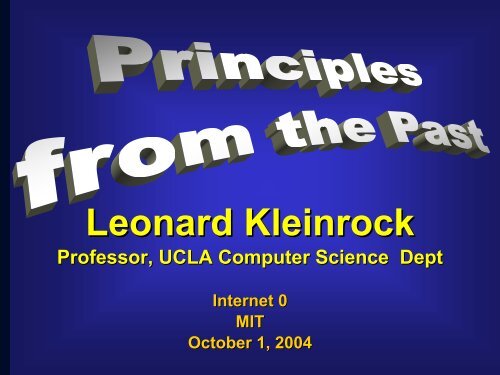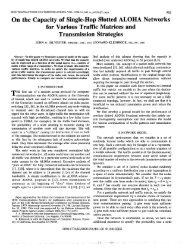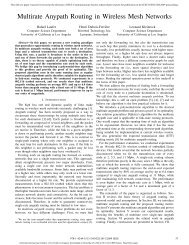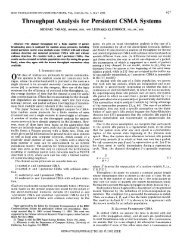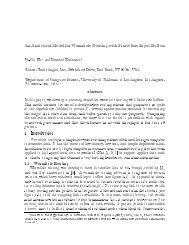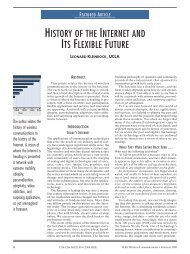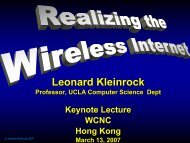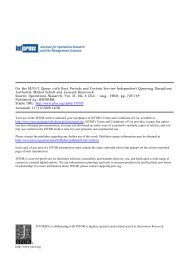Principles from the Past - Leonard Kleinrock - UCLA
Principles from the Past - Leonard Kleinrock - UCLA
Principles from the Past - Leonard Kleinrock - UCLA
You also want an ePaper? Increase the reach of your titles
YUMPU automatically turns print PDFs into web optimized ePapers that Google loves.
<strong>Leonard</strong> <strong>Kleinrock</strong><br />
Professor, <strong>UCLA</strong> Computer Science Dept<br />
© <strong>Leonard</strong> <strong>Kleinrock</strong> 2004<br />
Internet 0<br />
MIT<br />
October 1, 2004
My Early Years at MIT<br />
July 24, 1961<br />
Information Flow in Large Communication Nets<br />
<strong>Leonard</strong> <strong>Kleinrock</strong><br />
© <strong>Leonard</strong> <strong>Kleinrock</strong> 2004
“The purpose of this <strong>the</strong>sis is to investigate <strong>the</strong><br />
problems associated with information flow in large<br />
communication nets. ….”<br />
“…The nets under consideration consist of nodes,<br />
connected to each o<strong>the</strong>r by links. The nodes<br />
receive, sort, store, and transmit messages that<br />
enter and leave via <strong>the</strong> links….”<br />
Under what conditions does <strong>the</strong> net jam up<br />
Time lapse between initiation and reception<br />
Channel capacity<br />
Transient behavior and recovery time<br />
Storage capacity size<br />
Routing doctrine<br />
© <strong>Leonard</strong> <strong>Kleinrock</strong> 2004
A Ma<strong>the</strong>matical Theory of Data<br />
Networks<br />
• Channel capacity limited<br />
• Mean response time as key metric<br />
• Analytic model set up and solved<br />
• Optimal assignment of channel capacity<br />
• Choice of priority queueing discipline and <strong>the</strong><br />
introduction of packet switching<br />
• Distributed routing procedure<br />
• Design of topological structure<br />
• Elucidated underlying principles of data<br />
networks<br />
© <strong>Leonard</strong> <strong>Kleinrock</strong> 2004<br />
<strong>Kleinrock</strong>, L., Communication Nets; Stochastic Message Flow and<br />
Delay, McGraw-Hill Book Company, New York, 1964. Reprinted by<br />
Dover Publications, 1972. (Originally published as his 1962 PhD<br />
dissertation.)
Systems of Flow<br />
1. Steady flow through a single channel<br />
• Trivial and deterministic<br />
2. Unsteady flow through a single channel<br />
• Queueing <strong>the</strong>ory; stochastics get you<br />
3. Steady flow through a network of channels<br />
• Network flow <strong>the</strong>ory; multicommodity gets you<br />
4. Unsteady flow through a network of channels<br />
• A New domain; everything gets you!<br />
• Jackson’s networks of queues (1957)<br />
• <strong>Kleinrock</strong>’s Independence Assumption cracks <strong>the</strong> problem<br />
wide open<br />
© <strong>Leonard</strong> <strong>Kleinrock</strong> 2004
Key Equation for Networks<br />
T<br />
i<br />
T =<br />
λ i<br />
Σ γ<br />
i<br />
T i<br />
T =<br />
i<br />
Average network delay<br />
This is EXACT!!<br />
= Traffic on channel i (Msg/sec)<br />
= Network throughput (Msg/sec)<br />
T =<br />
i<br />
Average delay for channel i<br />
But how do you<br />
© <strong>Leonard</strong> <strong>Kleinrock</strong> 2004<br />
find this term
The Independence Assumption<br />
Each time that a message is received at a<br />
node within <strong>the</strong> net, a new length is<br />
chosen for this message independently<br />
<strong>from</strong> an exponential distribution<br />
• Without <strong>the</strong> Independence Assumption,<br />
<strong>the</strong> problem is intractable.<br />
• With <strong>the</strong> Independence Assumption, <strong>the</strong><br />
problem is totally manageable!!<br />
• We get:<br />
1<br />
where<br />
© <strong>Leonard</strong> <strong>Kleinrock</strong> 2004<br />
C i<br />
=<br />
T = i C i - i<br />
Capacity of channel i (Msg/sec)
Flow Control<br />
Seeking principles and<br />
underlying behavior<br />
© <strong>Leonard</strong> <strong>Kleinrock</strong> 2004
The Holland Tunnel<br />
Manhattan<br />
Hudson<br />
River<br />
New Jersey<br />
Holland<br />
Tunnel<br />
© <strong>Leonard</strong> <strong>Kleinrock</strong> 2004
The Holland Tunnel<br />
Manhattan<br />
Hudson<br />
River<br />
New Jersey<br />
Throughput<br />
(Cars/sec)<br />
Holland<br />
Tunnel<br />
ft/sec<br />
Car Density<br />
(Cars/foot)<br />
Total Jam<br />
© <strong>Leonard</strong> <strong>Kleinrock</strong> 2004
FLOW CONTROL<br />
Whoa !!<br />
PING !<br />
BIG<br />
!<br />
DP<br />
SYS<br />
© <strong>Leonard</strong> <strong>Kleinrock</strong> 2004<br />
COMPUTER<br />
NET
© <strong>Leonard</strong> <strong>Kleinrock</strong> 2004<br />
Constraints are Dangerous
Flow Control in Networks<br />
X<br />
…, 3, 2, 1<br />
© <strong>Leonard</strong> <strong>Kleinrock</strong> 2004
Throughput<br />
Loss<br />
Input<br />
CAPACITY<br />
Throughput<br />
0<br />
© <strong>Leonard</strong> <strong>Kleinrock</strong> 2004 Network Cloud<br />
LOSS
Flow Control<br />
Output<br />
0<br />
0<br />
IDEAL<br />
DYNAMIC<br />
CONSERVATIVE<br />
FREE-FLOW<br />
FLOW<br />
0<br />
Input<br />
DEADLOCK<br />
© <strong>Leonard</strong> <strong>Kleinrock</strong> 2004
Distributed Control<br />
• Routing Procedures:<br />
• Easy to design<br />
• Hard to analyze (dynamic)<br />
• Flow Control:<br />
• Hard to design<br />
• Outrageously difficult to analyze<br />
• Absolutely essential<br />
• Guaranteed to GET you!<br />
© <strong>Leonard</strong> <strong>Kleinrock</strong> 2004
Response Time<br />
Throughput<br />
Loss<br />
RESPONSE TIME<br />
T<br />
Input<br />
CAPACITY<br />
Throughput<br />
0<br />
© <strong>Leonard</strong> <strong>Kleinrock</strong> 2004 Network Cloud<br />
LOSS
Response Time vs Throughput<br />
T( )<br />
POWER =<br />
Throughput<br />
Response Time<br />
Do you want<br />
to operate here<br />
Or here<br />
= P =<br />
T( )<br />
Response<br />
Time<br />
0<br />
1/P<br />
<strong>Kleinrock</strong>, L., "On Flow Control in Computer Networks", Conference Record,<br />
Proceedings © <strong>Leonard</strong> <strong>Kleinrock</strong> of <strong>the</strong> International 2004 Conference on Communications, Vol. II,<br />
Toronto, Ontario, pp. 27.2.1 to 27.2.5, June 1978.<br />
*<br />
Throughput<br />
Max Power Point<br />
( )
Response Time vs Throughput<br />
T( )<br />
At Max Power<br />
N * = 1<br />
Response<br />
Time<br />
Max Power Point<br />
© <strong>Leonard</strong> <strong>Kleinrock</strong> 2004<br />
0<br />
*<br />
Throughput<br />
( )
N*=1<br />
T( )<br />
M/G/1<br />
0<br />
© <strong>Leonard</strong> <strong>Kleinrock</strong> 2004
Use Your Intuition<br />
Only 1 customer<br />
Insight:<br />
Just keep <strong>the</strong><br />
pipe full!<br />
© <strong>Leonard</strong> <strong>Kleinrock</strong> 2004<br />
T = Min<br />
Eff = Max
© <strong>Leonard</strong> <strong>Kleinrock</strong> 2004<br />
Highly Structured Systems<br />
• A.M. Radio<br />
Quality<br />
• Poor reception<br />
• Slowly gets worse with distance<br />
• F.M. Radio<br />
Quality<br />
• Good reception<br />
Distance<br />
• Catastrophically gets worse at critical distance<br />
• This tends to be true for many highly<br />
structured systems<br />
• Congestion systems<br />
• Error correcting codes<br />
• The one horse shay<br />
Distance
Simple 2-parameter 2<br />
Model<br />
For Delay<br />
Delay<br />
T<br />
T 0<br />
0<br />
Throughput<br />
*<br />
© <strong>Leonard</strong> <strong>Kleinrock</strong> 2004
Ano<strong>the</strong>r application of<br />
Power<br />
© <strong>Leonard</strong> <strong>Kleinrock</strong> 2004
A Brief History of Radio<br />
• Marconi 1890’s<br />
© <strong>Leonard</strong> <strong>Kleinrock</strong> 2004
A Brief History of Pkt Radio<br />
• 1970’s: ARPA<br />
250 cu in<br />
25 watts<br />
25 pounds<br />
<strong>Kleinrock</strong> 2004<br />
© <strong>Leonard</strong> <strong>Kleinrock</strong> 1999
A Brief History of Pkt Radio<br />
• 1990’s: ARPA<br />
10 cu in<br />
1 watt<br />
1 pound<br />
<strong>Kleinrock</strong> 2004<br />
© <strong>Leonard</strong> <strong>Kleinrock</strong> 1999
© <strong>Leonard</strong> <strong>Kleinrock</strong> 2004
© <strong>Leonard</strong> <strong>Kleinrock</strong> 2004
© <strong>Leonard</strong> <strong>Kleinrock</strong> 2004
Giant Stepping<br />
in Packet Radio<br />
• Multihop<br />
• Each hop covers distance R (Tx(<br />
Radius)<br />
• Total distance to cover is D (D>>R)<br />
• Big R, more interference, fewer hops<br />
• Small R, less interference, more hops<br />
• Total Delay = T(R)[D/R<br />
D/R]<br />
• Choose R=R * to minimize total delay<br />
• dT(R)/dR = T(R)/R optimality condition<br />
© <strong>Leonard</strong> <strong>Kleinrock</strong> 2004<br />
<strong>Kleinrock</strong>, L. "On Giant Stepping in Packet<br />
Radio Networks," <strong>UCLA</strong>, Packet Radio<br />
Temporary Note #5, PRT 136 , March 1975.
dT(R)/dR = T/R<br />
T(R)<br />
© <strong>Leonard</strong> <strong>Kleinrock</strong> 2004<br />
R *<br />
R
The General Optimization<br />
Problem (1961 LK)<br />
• Minimize<br />
T =<br />
Channel Capacity Assignment<br />
Routing Procedure<br />
Message queueing discipline<br />
Topology<br />
λ i<br />
Σ γ<br />
i<br />
T i<br />
© <strong>Leonard</strong> <strong>Kleinrock</strong> 2004<br />
• Subject to: D =<br />
Where Ci = Channel capacity of<br />
Σ<br />
i<br />
d i<br />
= Channel capacity of i th channel<br />
d i = Cost to supply 1 unit of capacity to i th channel<br />
D = Total dollars available for design<br />
C i
Solution to <strong>the</strong> Problem<br />
• Exact solution for d i = 1<br />
• Exact solution for arbitrary d i<br />
• Implications for topology<br />
• Implications for routing procedure<br />
• Implications for message sizes<br />
© <strong>Leonard</strong> <strong>Kleinrock</strong> 2004
The Underlying <strong>Principles</strong><br />
• Resource Sharing (demand access)<br />
© <strong>Leonard</strong> <strong>Kleinrock</strong> 2004<br />
• Only assign a resource to data that is present<br />
• Examples are:<br />
• Message switching<br />
• Packet switching<br />
• Polling<br />
• ATDM<br />
• Economy of Scale in Networks<br />
• Distributed control<br />
• It is efficient, stable, robust, fault-tolerant tolerant and<br />
WORKS!<br />
<strong>Kleinrock</strong>, L., Communication Nets; Stochastic Message Flow and Delay,<br />
McGraw-Hill Book Company, New York, 1964. Reprinted by Dover<br />
Publications, 1972. (Originally published as his 1962 PhD dissertation.)
Bursty Asynchronous Demands<br />
• You cannot predict exactly when<br />
<strong>the</strong>y will demand access<br />
• You cannot predict how much <strong>the</strong>y<br />
will demand<br />
• Most of <strong>the</strong> time <strong>the</strong>y do not need<br />
access<br />
• When <strong>the</strong>y ask for it, <strong>the</strong>y want<br />
immediate access!!<br />
© <strong>Leonard</strong> <strong>Kleinrock</strong> 2004
Conflict Resolution<br />
• Queueing:<br />
• One gets served<br />
• All o<strong>the</strong>rs wait<br />
• Splitting:<br />
• Each gets a piece of <strong>the</strong> resource<br />
• Blocking:<br />
• One gets served<br />
• All o<strong>the</strong>rs are refused<br />
• Smashing:<br />
• Nobody gets served !<br />
© <strong>Leonard</strong> <strong>Kleinrock</strong> 2004
Resource Sharing<br />
Type 0<br />
Type 1<br />
C<br />
C<br />
! !<br />
C<br />
Type 2<br />
C<br />
C<br />
C<br />
© <strong>Leonard</strong> <strong>Kleinrock</strong> 2004<br />
A Fancy Green Switch
The Law of Large Numbers<br />
(The First Resource Sharing Principle)<br />
• Although each member of a large population<br />
may behave in a random fashion, <strong>the</strong> population<br />
as a whole behaves in a predictable fashion.<br />
• This predictable fashion presents a total<br />
demand equal to <strong>the</strong> sum of <strong>the</strong> average<br />
demands of each member.<br />
• This is <strong>the</strong> “smoothing effect” of large<br />
populations.<br />
© <strong>Leonard</strong> <strong>Kleinrock</strong> 2004
Resource Sharing<br />
Type 0<br />
Type 1<br />
C<br />
C<br />
! !<br />
C<br />
Type 2<br />
Type 3<br />
C<br />
C<br />
C<br />
C<br />
C<br />
C<br />
© <strong>Leonard</strong> <strong>Kleinrock</strong> 2004<br />
A Fancy Green Switch<br />
A Fancy Green Switch
The Economy of Scale<br />
(The Second Resource Sharing Principle)<br />
• If you scale up throughput and capacity<br />
by some factor F, <strong>the</strong>n you reduce<br />
response time by that same factor.<br />
• If you scale capacity more slowly than<br />
throughput while holding response time<br />
constant, <strong>the</strong>n efficiency will increase<br />
(and can approach 100%).<br />
© <strong>Leonard</strong> <strong>Kleinrock</strong> 2004
© <strong>Leonard</strong> <strong>Kleinrock</strong> 2004<br />
Key Tradeoff:<br />
Response Time, Throughput, Efficiency<br />
100<br />
80<br />
Efficiency<br />
60<br />
40<br />
20<br />
0<br />
Response Time Improving,<br />
Throughput Increasing<br />
Constant Efficiency<br />
Constant Response Time<br />
Throughput Increasing<br />
Efficiency Improving<br />
Throughput<br />
Response Time Improving<br />
Throughput Increasing<br />
Efficiency Improving<br />
10<br />
4<br />
3<br />
2<br />
1 = Response<br />
Time, T
Economy of Scale in Networks<br />
Throughput<br />
Large<br />
Net<br />
Locus of<br />
Network Designs<br />
$/Kbps<br />
Kbps<br />
Small<br />
Net<br />
Small<br />
Net<br />
0<br />
Cost<br />
Slope = Kbps/$<br />
0<br />
Throughput<br />
Large<br />
Net<br />
© <strong>Leonard</strong> <strong>Kleinrock</strong> 2004
Key System Parameter<br />
a = Propag Delay/Pkt<br />
Tx Time<br />
= 5LC/b (# packets in cable)<br />
C = Bandwidth (megabits/sec)<br />
L = Cable Length (kilometers)<br />
PD = 5L (microseconds)<br />
SPEED<br />
MBPS<br />
PKT LNGTH<br />
BITS<br />
PROP DELAY<br />
MICROSEC<br />
LATENCY<br />
a<br />
LOCAL NET 10.00 1,000 5 0.05<br />
WIDE AREA NET 0.05 1,000 20,000 1.00<br />
SATELLITE 0.05 1,000 250,000 12.50<br />
FIBER LINK 1,000.00 1,000 20,000 20,000.00<br />
INTERNET 0 1.00 1,000 0.3 0.0003<br />
© <strong>Leonard</strong> <strong>Kleinrock</strong> 2004
Conclusions<br />
• Flow control is needed and tough<br />
• Look for principles<br />
• Be aware of prior work<br />
• Don’t fall in love with your model<br />
© <strong>Leonard</strong> <strong>Kleinrock</strong> 2004
© <strong>Leonard</strong> <strong>Kleinrock</strong> 2004<br />
www.lk.cs.ucla.edu


